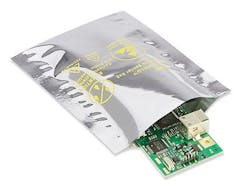COTS components in space: the storage barrier
By Dan Friedlander
Retired following 44 years in component engineering
The transition to using commercial off-the-shelf (COTS) components in space applications is a complex process. Many technical, psychological and emotional, and even political barriers have to be broken down to enable culture change.
One of those barriers is the well-rooted belief that COTS components are unable to meet their specifications (spec) after a relatively long storage period, largely because COTS components are meant for the commercial world. This world is associated with mass production, consuming the components shortly after their production, resulting in a very short shelf life, without negative impacts on the components.
The above is true for mass production. However, is worth mentioning that smaller-volume commercial production lines are also producing COTS components with reasonable success.
The space industry does not live (not yet) in a similar environment of mass production. Consequently, even the most organized space entities (military as well) cannot enjoy short shelf life. The relative long shelf life of components becomes a barrier to be dealt with on the way to using COTS parts in space applications.
Pragmatism in conjunction with risk management is the way to turn down the COTS storage barrier in the space industry.
“In meetings philosophy might work, on the field practicality works.” ― Amit Kalantri
COTS storage-related parameters
The parameters to be dealt with are:
Component Age
Shelf Life
Packing
Storage Policy
Different entities through different standards deal with the above parameters. It is my opinion that, without pragmatism, the task to follow the existing standards becomes an excessively difficult task to be implemented. Creativity and adaptation to the reality help to optimize practices.
Component age at the procurement phase
Component age is referenced to the date code. In context of the procurement phase, the age is the elapsed time from the component manufacturing timing to the delivery of the component to the user.
During the above-mentioned period, the components are not under the direct control of the user. In my multi-year practice, we integrated consistently in every order a requirement for a maximum delivered component’s age.
Not every component manufacturer or franchised distributor is happy meeting the age requirement. Nevertheless whomever is in the military and space business (like us) cannot just make life easy for these biased entities. History proves that a significant effort has been put forth to remove such a requirement. In spite of it, we kept the age requirement as is.
A National Electronic Distributors Association (NEDA) task force, comprised of electronics component manufacturers and authorized distributors, issued the "Managing Date Code Restrictions on Orders for Electronic Components, An Industry Position Paper" (Revision: December 2002).
In this paper, the authors refer to MIL-PRF-38535 (section 3.10) and MIL-PRF-19500 (section 6.2.j) as the origin of many customer date code (age) restriction requirements. The MIL-SPEC required (prior to 1995) that a military part be re-tested if not used within three years of the marked date code. This requirement was revised to remove date code restrictions altogether.
That is true; however, the MIL-SPEC covers military hermetic, lead (Pb)-containing termination finished components and does not cover COTS.
Nevertheless, the above NEDA paper reached the following extended conclusion: “The NEDA member component manufacturers and their authorized distributors recommend that general date code restrictions be eliminated from purchase order requirements for electronic components.”
What about the unlimited date code, consuming a significant part of the shelf life? As mentioned above, the military/space industry is not privileged to have mass production, receiving just-in-time deliveries and immediately use them.
The good news is that the NEDA only "recommend" (!) some manufacturers and/or distributors adopt this recommendation as a routine policy, demanding extra payment for those customers still requiring delivery of "fresh" components.
In the above paper, NEDA states the real drive to the removal of the date code restriction: "General date code restrictions result in further aging inventory in the supply chain by disrupting normal FIFO (First In First Out) consumption."
Two comments to that:
It is understood that not disrupted FIFO means the user always get the oldest stocked components.
For the manufacturers/distributors, FIFO means further aging inventory. However, the paper seems to support the idea that aging is not a problem!
Shelf life
There are two ends in a component supply chain: the component manufacturer and the component user. Each end uses the same terminology for different time periods.
The component manufacturer refers to shelf life from manufacture to shipment. The component user refers to shelf life from manufacturer to use or from receiving to use.
IPC/JEDEC J-STD-033 defines shelf life as: The time that a dry-packed, moisture-sensitive device may be stored in an unopened moisture barrier bag (MBB) such that the required interior bag ambient humidity is maintained.
My standpoint is: shelf life spans from receipt to use, complemented by an order requirement for a maximum component age (restricted date code). By the way, recently I met an anecdotal definition: "shelf life is the life of the shelf where you are keeping your electronic components"!
My understanding of the shelf life is that the user has to distinguish between two timeframes that added together makes up the total shelf life of the component
From manufacture to delivery: This time frame is not under the user’s control and consists of multiple activities at various locations, including at the manufacturer from date code to shipment, during shipment, at the distributor (stocking, packing, repacking), and at delivery hubs.
From the point of view of the user, this time frame shall be as short as possible and not exceed the date code restrictions set in the order.
From receiving to use: This timeframe is within full control of the user. The user is responsible for establishing and implementing a proper storage policy.
Component packing
Packing is an additional order requirement to ensure component integrity (mechanical, environmental, electrostatic discharge, etc.). Packing is also a discipline to be addressed within the storage policy.
Storage policy
The user shall develop a storage policy to fit the specific application requirements. To use COTS in space applications, more stringent measures shall be applied, based on pragmatic decisions, based on gained experience with COTS in military applications.
The main elements in the storage policy developed during my experience are:
All received EEE components are packed in MBB (Moisture Barrier Bag) meeting the requirements of MIL-B-81705 Type 1 (shielded, antistatic). The components are inserted in the MBB, nitrogen flushed, and sealed. This activity applies for components intended for military and space applications.
For components intended for space applications, the above MBBs (containing components) are stored in nitrogen desiccators or dry air desiccators (depending on predicted store time).
The above storage policy has proved itself to be suitable for the use of COTS in military and space applications.
Conclusion
The storage life barrier can be overcome by tearing down the barriers preventing use of COTS in space applications.
About the author
Search the Aerospace & Defense Buyer's Guide
The go-to resource for Intelligent Aerospace technology news & information:
Covering key topics
Across all market segments
Subscribe to the free Intelligent Inbox e-newsletter
Subscribe to receive all the latest aerospace technology news & information, delivered directly to your e-mail inbox twice a week (Tuesdays and Thursdays). Sign upfor your free subscription to the Intelligent Inbox e-newsletter at http://www.intelligent-aerospace.com/subscribe.html.
Connect on social media
Keep pace with aerospace innovation and opportunities via your favorite social media channels. Connect with Intelligent Aerospace on Twitter (@IntelligentAero), LinkedIn,Google+, and Instagram.




